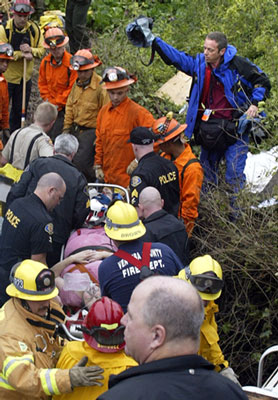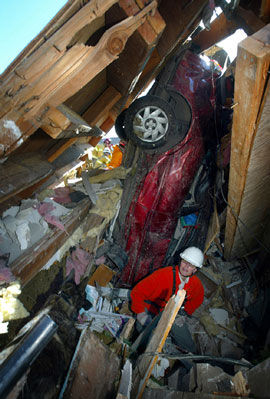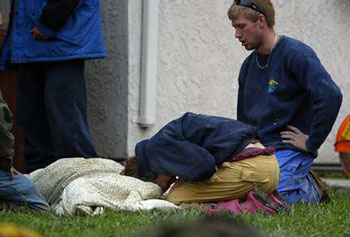 |
 | |||||||||
Close to Home
February 2005
|
|||||||||
|
On Jan. 10, after four days of soaking rain, a large section of the unstable bluff that towers over the small coastal town of La Conchita gave way, burying nearly a dozen homes and killing 10 people. I had covered some minor flooding in 1995, and witnessed a landslide in La Conchita firsthand. I ran for my life when the mudslide destroyed several homes, without fatalities. My photographs were made running backwards.
So when I got the call that the hillside, 15 minutes from my home in Santa Barbara, had collapsed again, I imagined what was unfolding, but not the scale. I was off sick when I got a call Monday, at quarter to two, saying, "Get in your car and go south." I was on the couch, sick, and in my car 10 minutes later. The 101 Freeway was closed from earlier mudslides both South and North, so most journalists, and many rescue personal were having trouble getting to the town. I talked my way past a CHP (California Highway Patrol) roadblock and drove through deep mud and past Caltrans crews attempting to clear a path. I arrived to pandemonium; residents and rescue workers were pulling survivors, while fire and police had been evacuating the town as a precaution when the slide happened.
The devastation was huge in my eyes, not Asia, but closer to home I guess. Two streets sat under 20 feet of mud. Firefighters and police stood at the top of a two-block wide mound of mud, working to locate survivors. People were frantically digging in piles of what was left of crushed homes. There were also broken gas lines and loose electrical wires. I had pretty good access the first 3 hours. After that, the authorities locked the place down. A Fire Chief from Los Angeles Fire Department had taken charge of the scene, and set up a yellow-tape perimeter because of the danger. The slide moved six feet sometime that first day and all rescue work stopped for several hours as geologists decided if it was safe even for the rescuers. I thought, I gotta get in here, and I can't stand at the yellow tape begging. So I approached the Search & Rescue K-9 people, and asked them if could document specifically what they were doing. It helped that I had all my own gear: a Kevlar helmet, fireproof gloves. steel-shank mud boots. They didn't have to outfit me, and I didn't need babysitting. I told them. I went first to the incident commander, then to the K-9 commander, and with all credentials and full gear, I was the only photographer inside the tape on the second day. At 5 a.m. on Tuesday I started following the K-9 team. They had four live-rescue dogs and four cadaver dogs. It was a feverish kind of effort, with the mountain moving, all this precarious stuff. I followed the first K9 rescue team to the center of town, and I watched Sonya Nordstrom climb into a deep hole between two homes. At first I could only hang my camera around the corner and try and photograph her efforts searching for trapped survivors. The woman is a civilian volunteer who trained her dog to be a live-rescue dog. This period was still well within the window of 48 hours, where that chance of survivability is still strong. It was an intense day. Behind me are 100+ rescuers, and every 15 minutes they call 'all quiet.' They had devices looking into different holes, backhoes, all looking for people. After a few minutes crews had cleared a larger opening and I was able to peek around into the hole. I was stunned to see a car standing on its front end. The power of the mudslide chilled me.
Bearing witness to this disaster, documenting my own neighbors, was really gut wrenching... I had known one of the ten victims. A good man, easy to be around, drink a beer with. I photographed his worn horse saddle resting on his coffin that Sunday. My only comfort will be if my images inspire someone to train a rescue dog, donate funds, or remind La Conchita families of their peril, because I don't imagine people are going to move out.
© Spencer Weiner
Dispatches are brought to you by Canon. Send Canon a message of thanks. |
|||||||||
Back to February 2005 Dispatches
|
|



